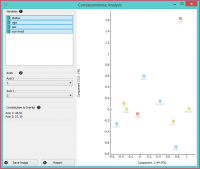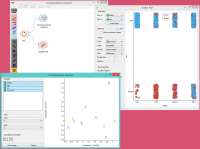Difference between revisions of "Orange: Correspondence Analysis"
Onnowpurbo (talk | contribs) (Created page with "Sumber: https://docs.biolab.si//3/visual-programming/widgets/unsupervised/correspondenceanalysis.html Correspondence analysis for categorical multivariate data. Inputs...") |
Onnowpurbo (talk | contribs) |
||
| Line 14: | Line 14: | ||
Correspondence Analysis (CA) computes the CA linear transformation of the input data. While it is similar to PCA, CA computes linear transformation on discrete rather than on continuous data. | Correspondence Analysis (CA) computes the CA linear transformation of the input data. While it is similar to PCA, CA computes linear transformation on discrete rather than on continuous data. | ||
| − | + | [[File:CorrespondenceAnalysis-stamped.png|center|200px|thumb]] | |
| + | |||
Select the variables you want to see plotted. | Select the variables you want to see plotted. | ||
| − | |||
Select the component for each axis. | Select the component for each axis. | ||
| − | |||
Inertia values (percentage of independence from transformation, i.e. variables are in the same dimension). | Inertia values (percentage of independence from transformation, i.e. variables are in the same dimension). | ||
| − | |||
Produce a report. | Produce a report. | ||
| − | + | ==Contoh== | |
Below, is a simple comparison between the Correspondence Analysis and Scatter Plot widgets on the Titanic dataset. While the Scatter Plot shows fairly well which class and sex had a good survival rate and which one didn’t, Correspondence Analysis can plot several variables in a 2-D graph, thus making it easy to see the relations between variable values. It is clear from the graph that “no”, “male” and “crew” are related to each other. The same goes for “yes”, “female” and “first”. | Below, is a simple comparison between the Correspondence Analysis and Scatter Plot widgets on the Titanic dataset. While the Scatter Plot shows fairly well which class and sex had a good survival rate and which one didn’t, Correspondence Analysis can plot several variables in a 2-D graph, thus making it easy to see the relations between variable values. It is clear from the graph that “no”, “male” and “crew” are related to each other. The same goes for “yes”, “female” and “first”. | ||
| − | + | [[File:CorrespondenceAnalysis-Example.png|center|200px|thumb]] | |
| + | |||
Revision as of 07:42, 24 January 2020
Sumber: https://docs.biolab.si//3/visual-programming/widgets/unsupervised/correspondenceanalysis.html
Correspondence analysis for categorical multivariate data.
Inputs
Data: input dataset
Outputs
Coordinates: coordinates of all components
Correspondence Analysis (CA) computes the CA linear transformation of the input data. While it is similar to PCA, CA computes linear transformation on discrete rather than on continuous data.
Select the variables you want to see plotted. Select the component for each axis. Inertia values (percentage of independence from transformation, i.e. variables are in the same dimension). Produce a report.
Contoh
Below, is a simple comparison between the Correspondence Analysis and Scatter Plot widgets on the Titanic dataset. While the Scatter Plot shows fairly well which class and sex had a good survival rate and which one didn’t, Correspondence Analysis can plot several variables in a 2-D graph, thus making it easy to see the relations between variable values. It is clear from the graph that “no”, “male” and “crew” are related to each other. The same goes for “yes”, “female” and “first”.

